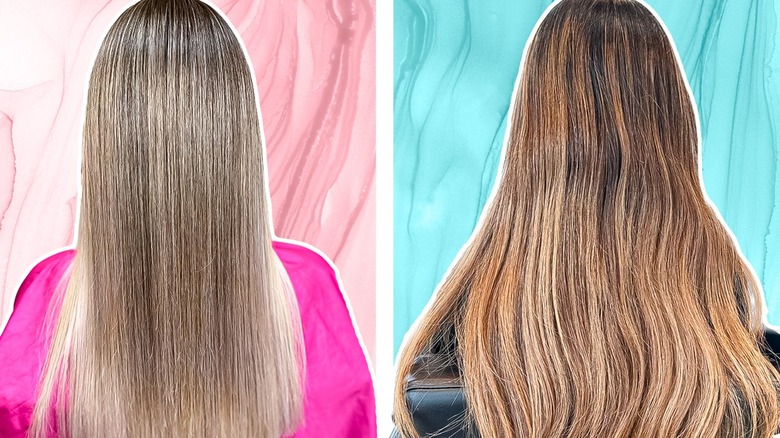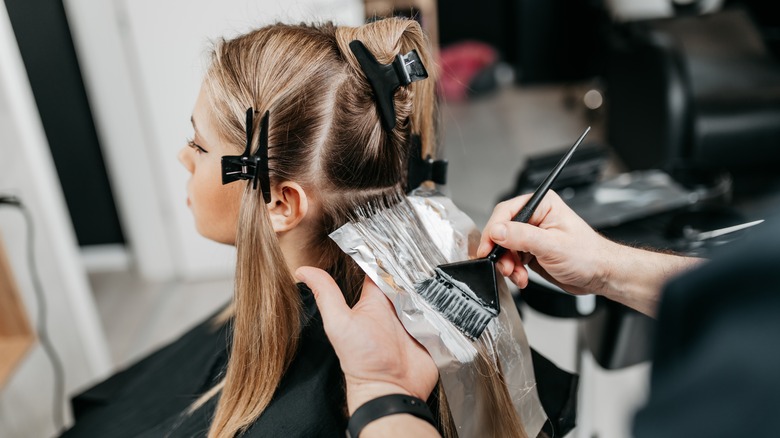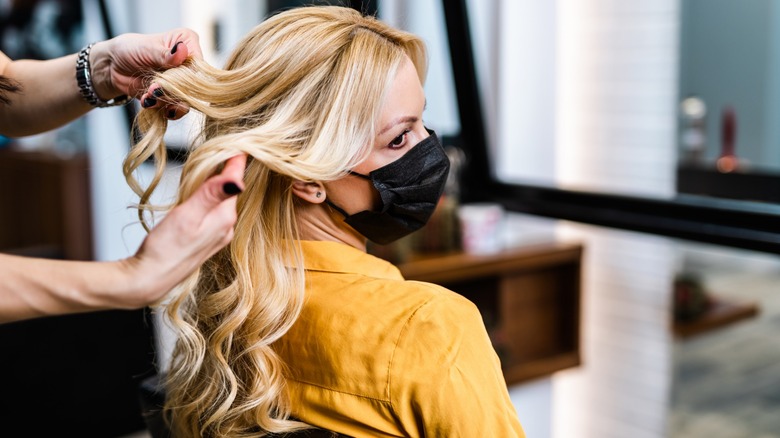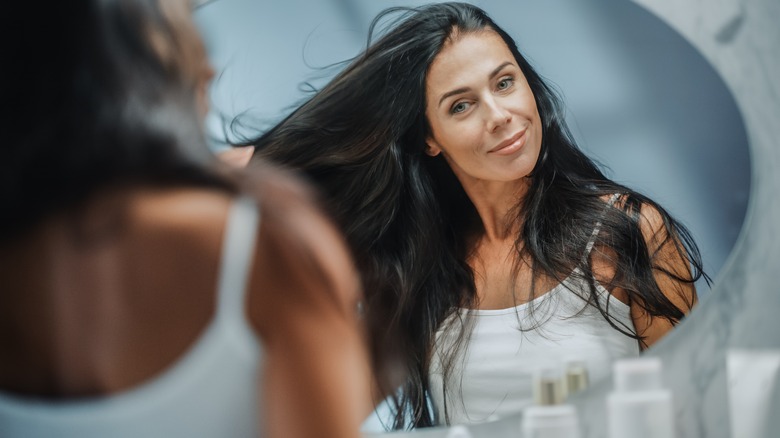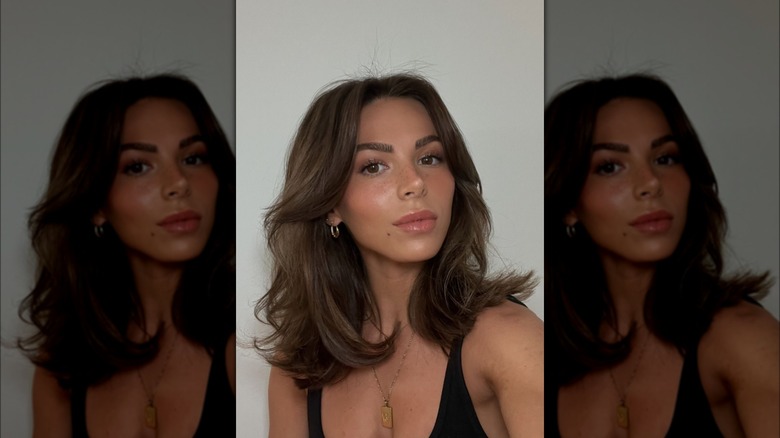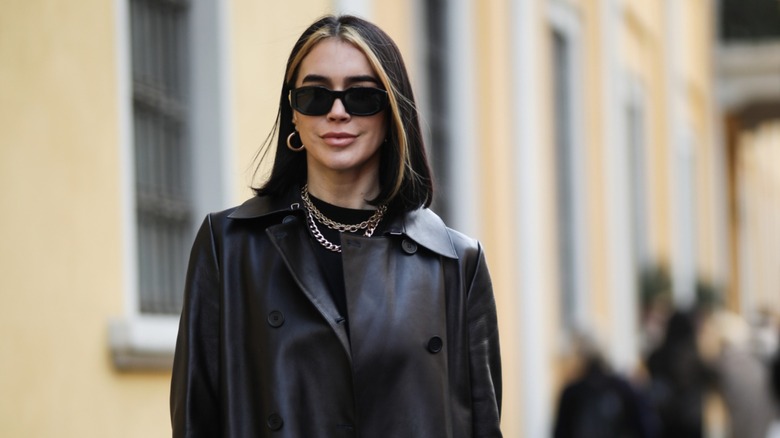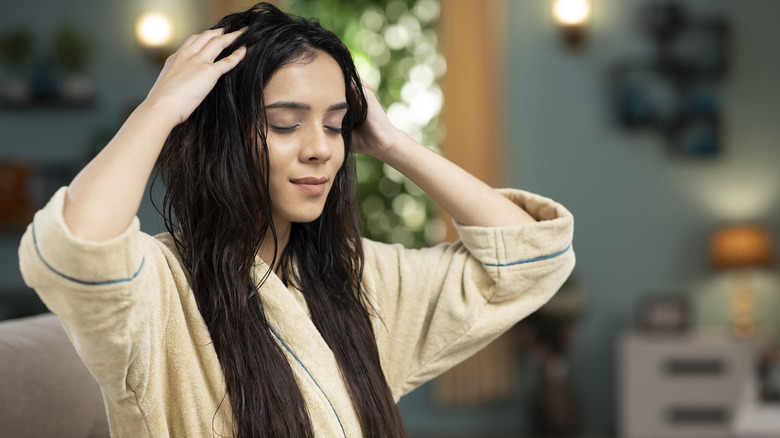Highlights Vs. Lowlights: The Differences, Explained
If you've ever spent time at a salon, you've probably heard the words "highlights" and "lowlights" used. While hair color techniques like balayage and ombre are well-known, highlights and lowlights can be more confusing because they're applied similarly. Highlights and lowlights offer distinct benefits to those looking for a fresh, new color.
Highlights and lowlights are some of the most common hair techniques because they involve simple changes but deliver significant results. They instantly brighten or darken the hair in distinct ways to give it new life. Highlights are typical in the warmer months since they mimic a sun-kissed glow from the sun. In the fall or winter, more people gravitate towards lowlights since they add a darker and more visually contrasting feel to their hair. While you can leave it up to your hairdresser, it's good to know which technique suits your hair and which is a better option for your goals.
Highlights brighten the hair
In general, the purpose of highlights is to brighten the hair and give it the appearance of a sun-kissed glow. As the name suggests, highlights help highlight aspects of the hair with lighter tones — they are typically two to three shades lighter than the hair's base color. In recent trends, we've seen how highlights can be applied in two forms. They can be added in small, dispersed pieces for a subtle brightening or in large chunks for a Y2K style.
Unlike lowlights, highlights are applied by bleaching and dyeing the hair, which makes the hair lighter. Applied in a solid form, there is no gradient effect, and they appear to be one uniform, lighter tone. Through foil highlights, you can get brighter and more saturated highlights with a more concentrated shade. Because highlights brighten the hair, they can be less subtle than lowlights in terms of difference from the base color. Highlights can also be applied alone if you want to lighten your hair for a brighter tone.
Lowlights add contrast
Unlike highlights, lowlights are strands dyed darker than your base hair color. This darker shade creates a stark contrast against your base color and highlights, making them pop up against your skin. Against lighter hues, lowlights will create enough contrast that makes your base color appear brighter. Contrast is needed in your hair to give your color more life, but you don't need an opposing color to create it. Lowlights that are one shade darker than your base color are enough to create a dynamic hair color.
Lowlights can help elevate your highlights through contrast without radically changing the color. Even for those not looking to lighten their hair, lowlights can provide enough contrast to freshen the look of a base color. For those looking for a radical change without having to bleach or dye their hair, lowlights can be a solution. You can also use the contrast from lowlights to mix opposite colors for an unexpected hair color design.
How highlights work with different hair colors
When applied together, highlights and lowlights can work with any hair color. However, if only one is applied, it may work best with certain colors. Highlights can easily be incorporated into any base hair color since there's always a lighter color available. You can also opt for warmer or cooler tones from your base hair color for the same effect. Those with already dyed hair should seek help from a professional, as highlights require bleach to lift color. Bleached hair can be dry and complicated to re-dye, making it difficult to get the exact color you want at home.
Lowlights work with most hair colors, except those with jet-black or dark hair. Because there isn't a shade darker than black, it's challenging to create the same shadows and contrast with lowlights. While you can opt for a colder tone for a bit of dimension, it will be the same tone as your base color. If you have black hair, highlights will give you the same contrast against your dark base hair color.
How highlights create dimension and volume
Both highlights and lowlights add something different to your hair, but lowlights give your hair the illusion of more volume and dimension. With the contrast created from the darker shades, lowlights develop the appearance of having more hair than there is — because they give your hair shadows, it looks like there's more depth. Slowly adding depth to the hair is also a great way to transition to a darker color over time. For those with fine or thin hair, lowlights can create fuller-looking hair with plenty of volume.
Highlights brighten up your hair, but they can also fall flat. If you over-brighten your hair, the color may immediately appear plain and wash you out. Lowlights fix this problem by giving your hair more dimension and movement. If you have flat, straight hair, they can be an easy fix to give you the volume you want without hairstyling products. Lowlights also blend in with your natural hair color, giving you a more authentic look.
Highlights are defined and obvious
Since highlights are laid on top of your base color throughout your hair, they're more noticeable than lowlights. They can be more of a statement hair design than lowlights as well — highlights can be as dramatic as you want, giving you more flexibility in how you wear them. If you're looking to make a statement, chunky highlights simply lighten bigger segments of hair. These chunks can give you a classic Y2K style that's defined and noticeable. Apart from chunky highlights, you can also opt for money pieces that frame the hair next to your face. These pieces can lighten the appearance of your skin tone.
Lowlights are more subtle since they're only visible from mid-shaft to the hair ends. Because they're a darker hue, you likely won't notice them unless you're under light. Depending on the highlighting technique, it's possible to achieve subtle color changes, but they require a more complex application. The definition from these highlights can create movement and texture through their stark definition.
Lowlights cause less damage
One of the crucial differences between highlights and lowlights is what it means for your hair's health. Since highlights involve lifting the color from the strand, you need a harsher formula than lowlights. With lowlights, you may just need to dye the strand and add gloss or another hair treatment to seal the color. Highlights require more chemicals to strip the original color and lighten it to your desired shade. This process can dry and damage the hair over time, especially when done frequently. If proper precautions aren't taken, your highlights can transform into an undesired shade and produce split ends.
Any frequent chemical or dyeing process can affect your hair's health. Lowlights are the best option for those concerned about keeping their hair healthy while giving it another look. While some products can remedy the damage from highlights, there's no doubt that it's the most aggressive option of the two.
